First Clinical Evidence Linking Smoking to Increased Postoperative Macular and Retinal Nerve Fiber Layer Thickness in Cataract Surgery Patients: A Prospective Cohort Study
Abstract
1. Introduction
2. Materials and Methods
2.1. Study Design
2.2. Study Participants
2.3. OCT and Other Measurements
2.4. Surgery and Anesthesia
2.5. Primary Endpoint
2.6. Secondary Outcome Measure
2.7. Statistical Analysis
3. Results
3.1. Study Population
3.2. Cross-Sectional Comparisons at Each Timepoint
3.3. Mixed-Effects Longitudinal Analysis
3.4. Association of Phacoemulsification Time with Postoperative Changes
3.5. Multivariable Regression Across Sequential Time Intervals
4. Discussion
5. Conclusions
Author Contributions
Funding
Institutional Review Board Statement
Informed Consent Statement
Data Availability Statement
Conflicts of Interest
Abbreviations
| AMD | age-related macular degeneration |
| BMI | body mass index |
| CAT | cube average thickness |
| CDR | cup-to-disk ratio |
| CDE | cumulative dissipated energy |
| CI | confidence interval |
| CST | central subfoveal thickness |
| CV | cube volume |
| FAZ | foveal avascular zone |
| GBD | Global Burden of Disease |
| IOL | intraocular lens |
| LOCS 3 | Lens Opacities Classification System III |
| LR | likelihood ratio (test) |
| NSAID | non-steroidal anti-inflammatory drug |
| NS | non-smokers (group identifier) |
| OCT | optical coherence tomography |
| pc-s | percent-seconds (unit used for CDE) |
| POD | postoperative day |
| RNFL | retinal nerve fiber layer |
| S | smokers (group identifier) |
| SPSS | (IBM) Statistical Package for the Social Sciences |
| STROBE | Strengthening the Reporting of Observational Studies in Epidemiology |
References
- Khanna, R.; Pujari, S.; Sangwan, V. Cataract Surgery in Developing Countries. Curr. Opin. Ophthalmol. 2011, 22, 10–14. [Google Scholar] [CrossRef]
- Cicinelli, M.V.; Buchan, J.C.; Nicholson, M.; Varadaraj, V.; Khanna, R.C. Cataracts. Lancet 2023, 401, 377–389. [Google Scholar] [CrossRef] [PubMed]
- GBD 2019 Tobacco Collaborators. Spatial, Temporal, and Demographic Patterns in Prevalence of Smoking Tobacco Use and Attributable Disease Burden in 204 Countries and Territories, 1990–2019: A Systematic Analysis from the Global Burden of Disease Study 2019. Lancet 2021, 397, 2337–2360. [Google Scholar] [CrossRef] [PubMed]
- Karimi, S.; Nouri, H.; Mahmoudinejad-Azar, S.; Abtahi, S.-H. Smoking and Environmental Tobacco Smoke Exposure: Implications in Ocular Disorders. Cutan. Ocul. Toxicol. 2023, 42, 1–7. [Google Scholar] [CrossRef] [PubMed]
- Yuen, B.G.; Tham, V.M.; Browne, E.N.; Weinrib, R.; Borkar, D.S.; Parker, J.V.; Uchida, A.; Vinoya, A.C.; Acharya, N.R. Association between Smoking and Uveitis: Results from the Pacific Ocular Inflammation Study. Ophthalmology 2015, 122, 1257–1261. [Google Scholar] [CrossRef]
- Nita, M.; Grzybowski, A. Smoking and Eye Pathologies. A Systemic Review. Part II. Retina Diseases, Uveitis, Optic Neuropathies, Thyroid-Associated Orbitopathy. Curr. Pharm. Des. 2017, 23, 639–654. [Google Scholar] [CrossRef]
- Yang, T.-K.; Huang, X.-G.; Yao, J.-Y. Effects of Cigarette Smoking on Retinal and Choroidal Thickness: A Systematic Review and Meta-Analysis. J. Ophthalmol. 2019, 2019, 8079127. [Google Scholar] [CrossRef]
- Anastasilakis, K.; Mourgela, A.; Symeonidis, C.; Dimitrakos, S.A.; Ekonomidis, P.; Tsinopoulos, I. Macular Edema after Uncomplicated Cataract Surgery: A Role for Phacoemulsification Energy and Vitreoretinal Interface Status? Eur. J. Ophthalmol. 2015, 25, 192–197. [Google Scholar] [CrossRef]
- Ilveskoski, L.; Taipale, C.; Tuuminen, R. Anti-Inflammatory Medication of Cataract Surgery in Pseudoexfoliation Syndrome—NSAID Is Needed. Curr. Eye Res. 2020, 45, 814–819. [Google Scholar] [CrossRef]
- Pujol-Lereis, L.M.; Schäfer, N.; Kuhn, L.B.; Rohrer, B.; Pauly, D. Interrelation Between Oxidative Stress and Complement Activation in Models of Age-Related Macular Degeneration. Adv. Exp. Med. Biol. 2016, 854, 87–93. [Google Scholar] [CrossRef]
- Nebbioso, M.; Vestri, A.; Gharbiya, M.; D’Andrea, M.; Calbucci, M.; Pasqualotto, F.; Esposito, S.; D’Amico, A.; Castellani, V.; Carlesimo, S.C.; et al. Multidisciplinary Clinical Study on Retinal, Circulatory, and Respiratory Damage in Smoking-Dependent Subjects. Medicina 2025, 61, 347. [Google Scholar] [CrossRef] [PubMed]
- Quiroz-Reyes, M.A.; Quiroz-Gonzalez, E.A.; Quiroz-Gonzalez, M.A.; Lima-Gomez, V. Effects of Cigarette Smoking on Retinal Thickness and Choroidal Vascularity Index: A Systematic Review and Meta-Analysis. Int. J. Retina Vitreous 2025, 11, 21. [Google Scholar] [CrossRef]
- Yao, H.; Yang, Z.; Cheng, Y.; Shen, X. Macular Changes Following Cataract Surgery in Eyes with Early Diabetic Retinopathy: An OCT and OCT Angiography Study. Front. Med. 2023, 10, 1290599. [Google Scholar] [CrossRef] [PubMed]
- Bajraktari, G.; Jukić, T.; Kalauz, M.; Oroz, M.; Radolović Bertetić, A.; Vukojević, N. Early and Late Complications after Cataract Surgery in Patients with Uveitis. Medicina 2023, 59, 1877. [Google Scholar] [CrossRef]
- Batistic, D.; Kreso, A.; Vrdoljak, J.; Batistic, J.; Paladin, I.; Mizdrak, I.; Glumac, S. An Analysis of Optic Disc Parameters in Patients with Peripheral Retinal Tears Following Acute Posterior Vitreous Detachment: A Cross-Sectional Study. Clin. Interv. Aging 2024, 19, 1153–1162. [Google Scholar] [CrossRef] [PubMed]
- Canada, H. Canadian Tobacco Use Monitoring Survey: Terminology. Available online: https://www.canada.ca/en/health-canada/services/health-concerns/tobacco/research/tobacco-use-statistics/terminology.html (accessed on 5 May 2025).
- Rodríguez-Molinero, A.; Narvaiza, L.; Ruiz, J.; Gálvez-Barrón, C. Normal Respiratory Rate and Peripheral Blood Oxygen Saturation in the Elderly Population. J. Am. Geriatr. Soc. 2013, 61, 2238–2240. [Google Scholar] [CrossRef]
- Ćurić, A.; Bjeloš, M.; Bušić, M.; Kuzmanović Elabjer, B.; Rak, B.; Vukojević, N. Long-Term Functional Hyperemia after Uncomplicated Phacoemulsification: Benefits beyond Restoring Vision. Diagnostics 2022, 12, 2449. [Google Scholar] [CrossRef]
- Kim, B.-J.; Ahn, Y.J.; Oh, H.-Y.; Choi, S.I.; Yoo, Y.-S.; Whang, W.-J.; Byun, Y.-S.; Lee, M.-Y.; Joo, C.-K. Assessment for Macular Thickness after Uncomplicated Phacoemulsification Using Optical Coherence Tomography. Korean J. Ophthalmol. 2022, 36, 296–305. [Google Scholar] [CrossRef]
- Dabas, G.; Shukla, P.; Mithal, K.; Bhartiya, S.; Singh, V.P.; Agarwal, S. Central Macular Thickness Change after Uneventful Small-Incision Cataract Surgery—An Observational Study. Indian J. Ophthalmol. 2022, 70, 3995. [Google Scholar] [CrossRef]
- Surl, D.; Kim, S.; Kim, S.; Kim, T.-I.; Seo, K.Y.; Jun, I. Comparative Analysis of Changes in Retinal Layer Thickness Following Femtosecond Laser-Assisted Cataract Surgery and Conventional Cataract Surgery. BMC Ophthalmol. 2024, 24, 276. [Google Scholar] [CrossRef]
- Mackenbrock, L.H.B.; Baur, I.D.; Łabuz, G.; Auffarth, G.U.; Khoramnia, R. Impact of Phacoemulsification Parameters on Central Retinal Thickness Change Following Cataract Surgery. Diagnostics 2023, 13, 2856. [Google Scholar] [CrossRef]
- Moschos, M.M.; Nitoda, E.; Laios, K.; Ladas, D.S.; Chatziralli, I.P. The Impact of Chronic Tobacco Smoking on Retinal and Choroidal Thickness in Greek Population. Oxid. Med. Cell. Longev. 2016, 2016, 2905789. [Google Scholar] [CrossRef]
- Teberik, K. The Effect of Smoking on Macular, Choroidal, and Retina Nerve Fiber Layer Thickness. Turk. J. Ophthalmol. 2019, 49, 20–24. [Google Scholar] [CrossRef] [PubMed]
- Cui, B.; He, K.; Zhang, X.; Zhou, W.; Sun, Z.; Zhang, M.; Shi, Y.; Lei, Y.; Yao, L.; Li, Y.; et al. Association of Cigarette Smoking with Retinal Thickness and Vascular Structure in an Elderly Chinese Population. Photodiagnosis Photodyn. Ther. 2021, 36, 102481. [Google Scholar] [CrossRef] [PubMed]
- Rokh, M.A.E.; Gaber, R.A.; Eldesoky, E.E.; Ghoraba, H.H. The Influence of Smoking on Choroidal, Macular and Retinal Nerve Fiber Layer Thickness. J. Adv. Med. Med. Res. 2021, 33, 46–55. [Google Scholar] [CrossRef]
- Massa, H.; Pipis, S.Y.; Adewoyin, T.; Vergados, A.; Patra, S.; Panos, G.D. Macular Edema Associated with Non-Infectious Uveitis: Pathophysiology, Etiology, Prevalence, Impact and Management Challenges. Clin. Ophthalmol. 2019, 13, 1761–1777. [Google Scholar] [CrossRef]
- Browning, D.J.; Stewart, M.W.; Lee, C. Diabetic Macular Edema: Evidence-Based Management. Indian. J. Ophthalmol. 2018, 66, 1736–1750. [Google Scholar] [CrossRef]
- Urs, R.; Ketterling, J.A.; Yu, A.C.H.; Lloyd, H.O.; Yiu, B.Y.S.; Silverman, R.H. Ultrasound Imaging and Measurement of Choroidal Blood Flow. Transl. Vis. Sci. Technol. 2018, 7, 5. [Google Scholar] [CrossRef]
- Seo, Y.-S.; Park, J.-M.; Kim, J.-H.; Lee, M.-Y. Cigarette Smoke-Induced Reactive Oxygen Species Formation: A Concise Review. Antioxidants 2023, 12, 1732. [Google Scholar] [CrossRef]
- Datta, S.; Cano, M.; Ebrahimi, K.; Wang, L.; Handa, J.T. The Impact of Oxidative Stress and Inflammation on RPE Degeneration in Non-Neovascular AMD. Prog. Retin. Eye Res. 2017, 60, 201–218. [Google Scholar] [CrossRef]
- Iafe, N.A.; Phasukkijwatana, N.; Chen, X.; Sarraf, D. Retinal Capillary Density and Foveal Avascular Zone Area Are Age-Dependent: Quantitative Analysis Using Optical Coherence Tomography Angiography. Investig. Ophthalmol. Vis. Sci. 2016, 57, 5780–5787. [Google Scholar] [CrossRef] [PubMed]
- Yu, M.; Lin, C.; Weinreb, R.N.; Lai, G.; Chiu, V.; Leung, C.K.-S. Risk of Visual Field Progression in Glaucoma Patients with Progressive Retinal Nerve Fiber Layer Thinning: A 5-Year Prospective Study. Ophthalmology 2016, 123, 1201–1210. [Google Scholar] [CrossRef] [PubMed]
- Bellocq, D.; Mathis, T.; Voirin, N.; Bentaleb, Z.M.; Sallit, R.; Denis, P.; Kodjikian, L. Incidence of Irvine Gass Syndrome after Phacoemulsification with Spectral-Domain Optical Coherence Tomography. Ocul. Immunol. Inflamm. 2019, 27, 1224–1231. [Google Scholar] [CrossRef] [PubMed]
- Schultz, T.; Joachim, S.C.; Stellbogen, M.; Dick, H.B. Prostaglandin Release during Femtosecond Laser-Assisted Cataract Surgery: Main Inducer. J. Refract. Surg. 2015, 31, 78–81. [Google Scholar] [CrossRef]
- Khalifa, A.M.; Shebl, A.A.; Farid, M.F.; Gad, E.A. Effect of Smoking on Macular Perfusion Using Optical Coherence Tomography Angiography. Benha Med. J. 2025, 42, 103–112. [Google Scholar] [CrossRef]
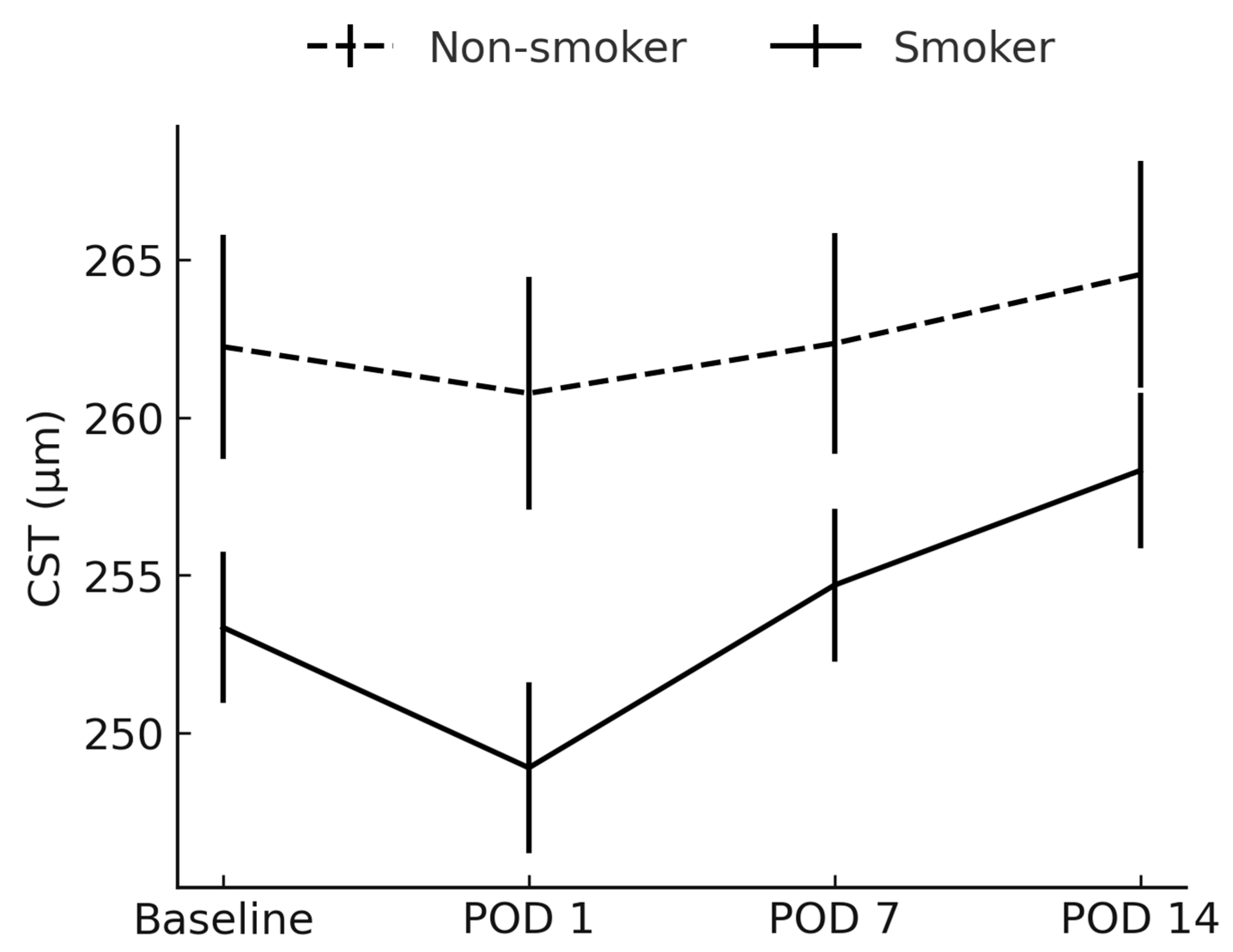
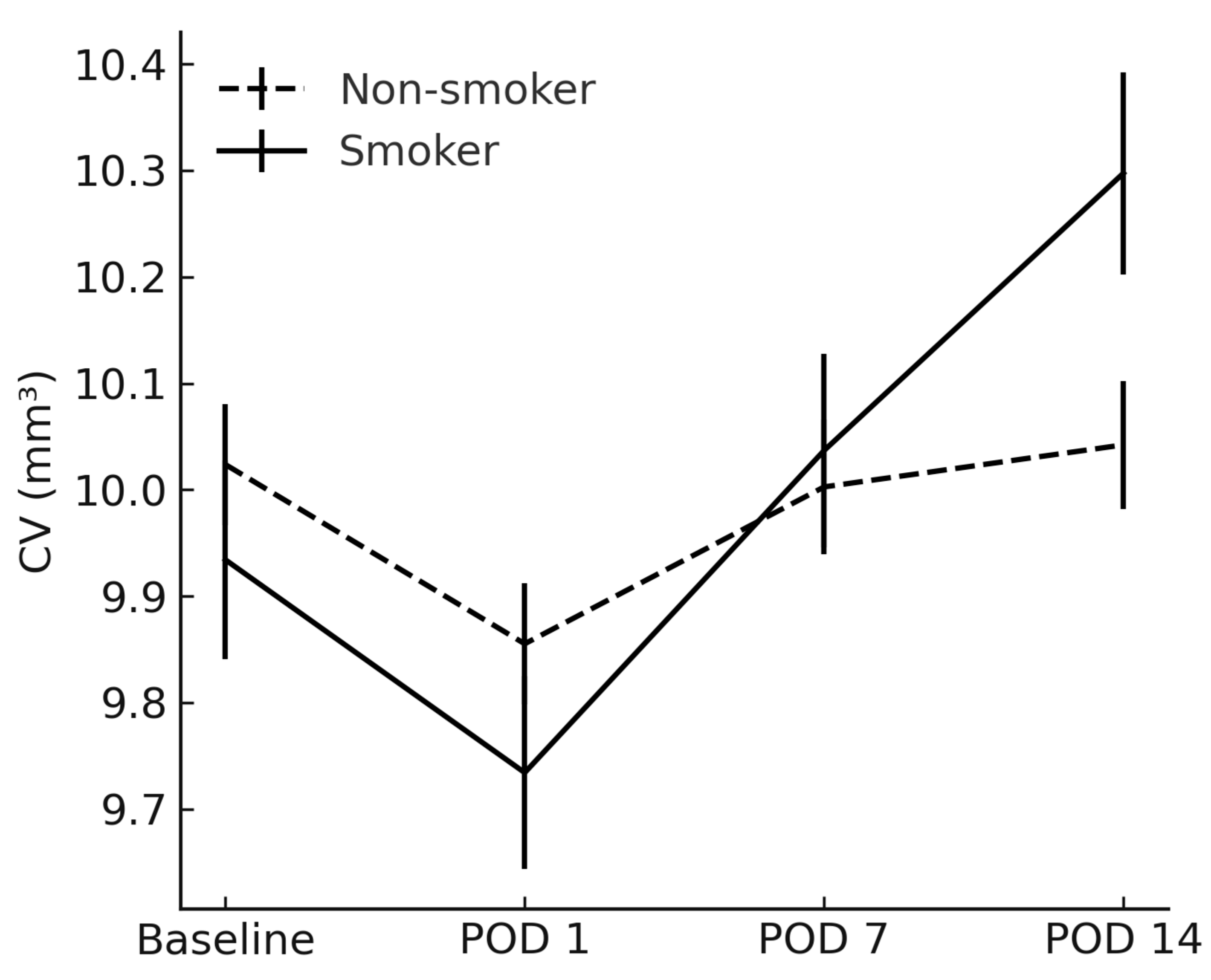
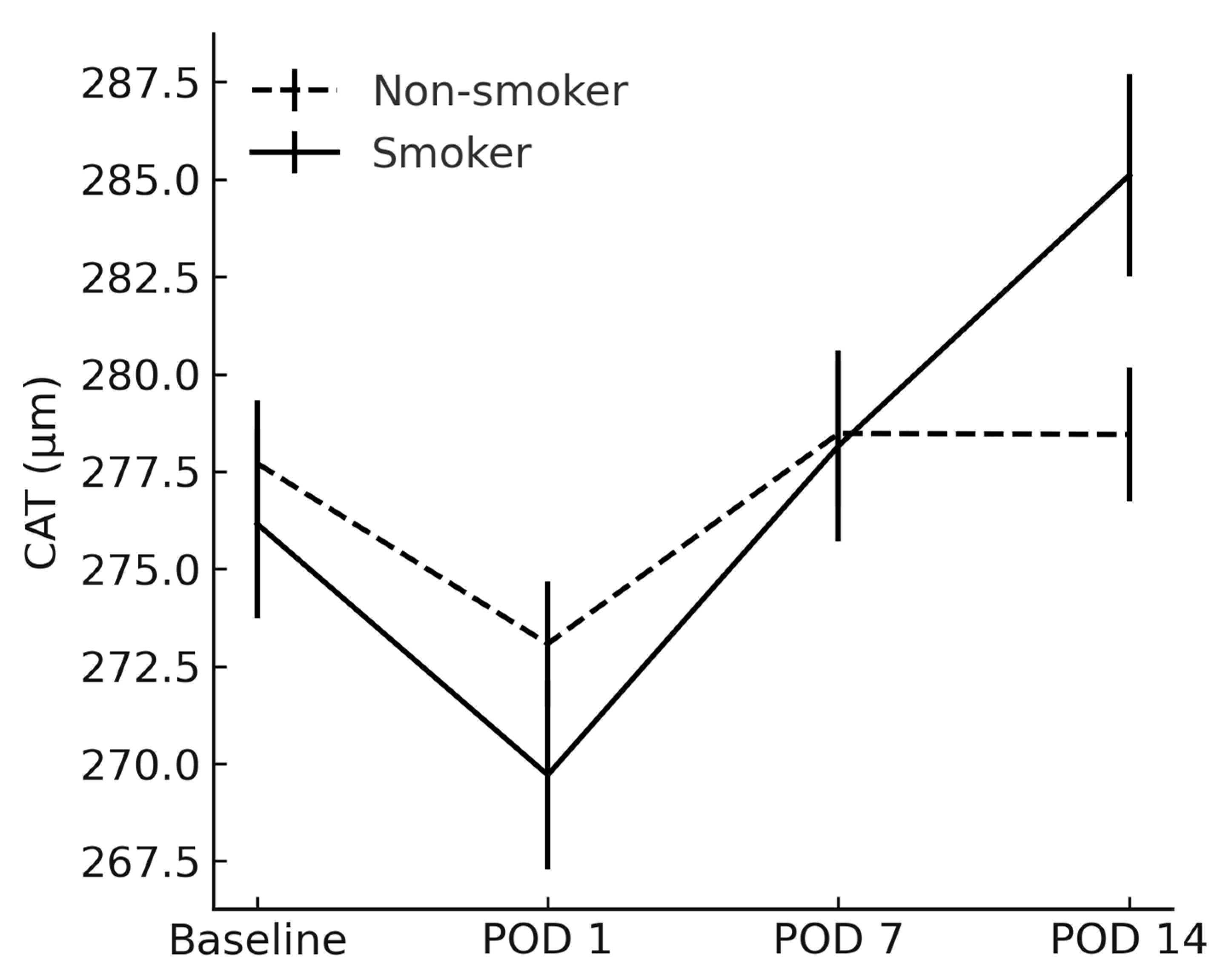
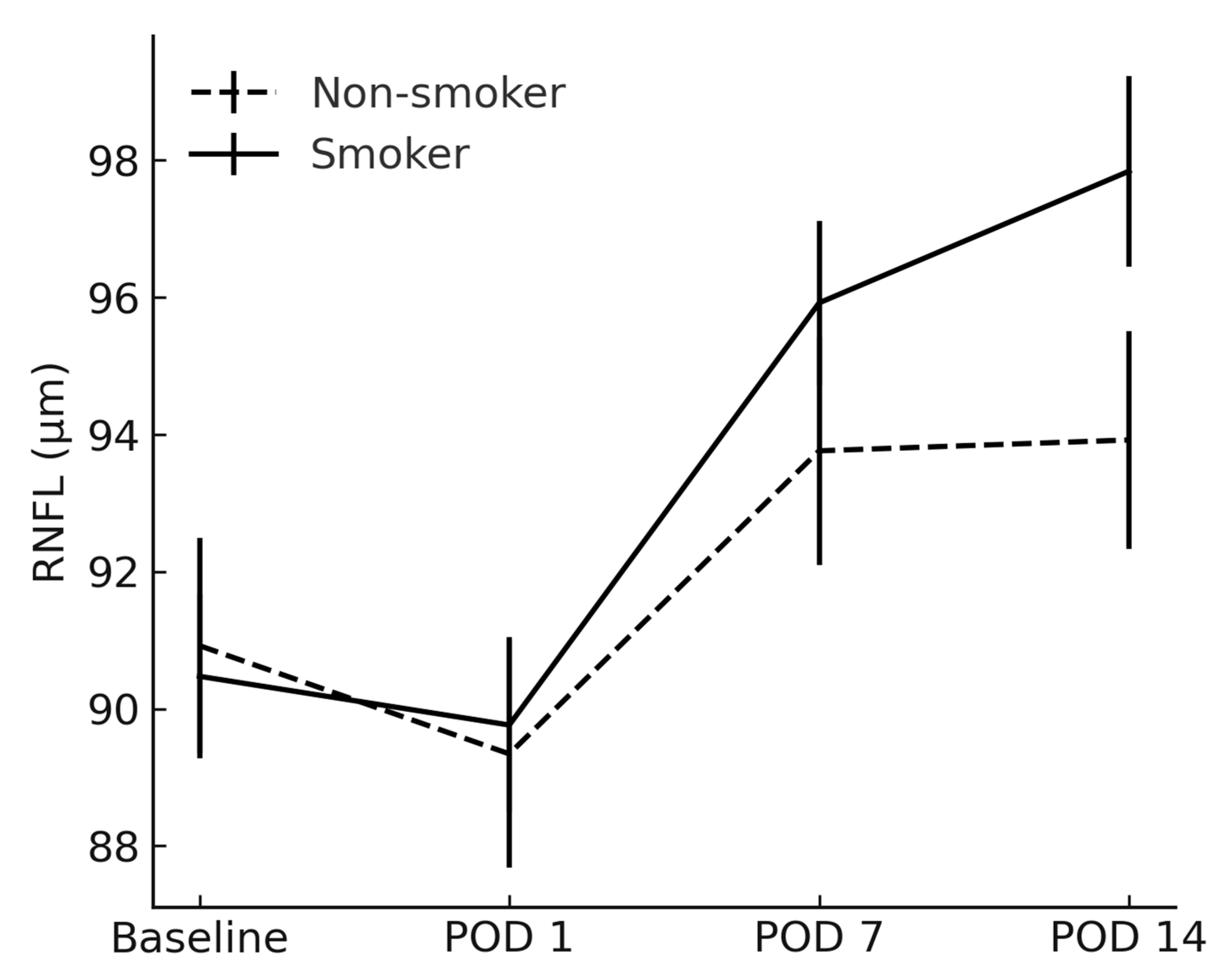
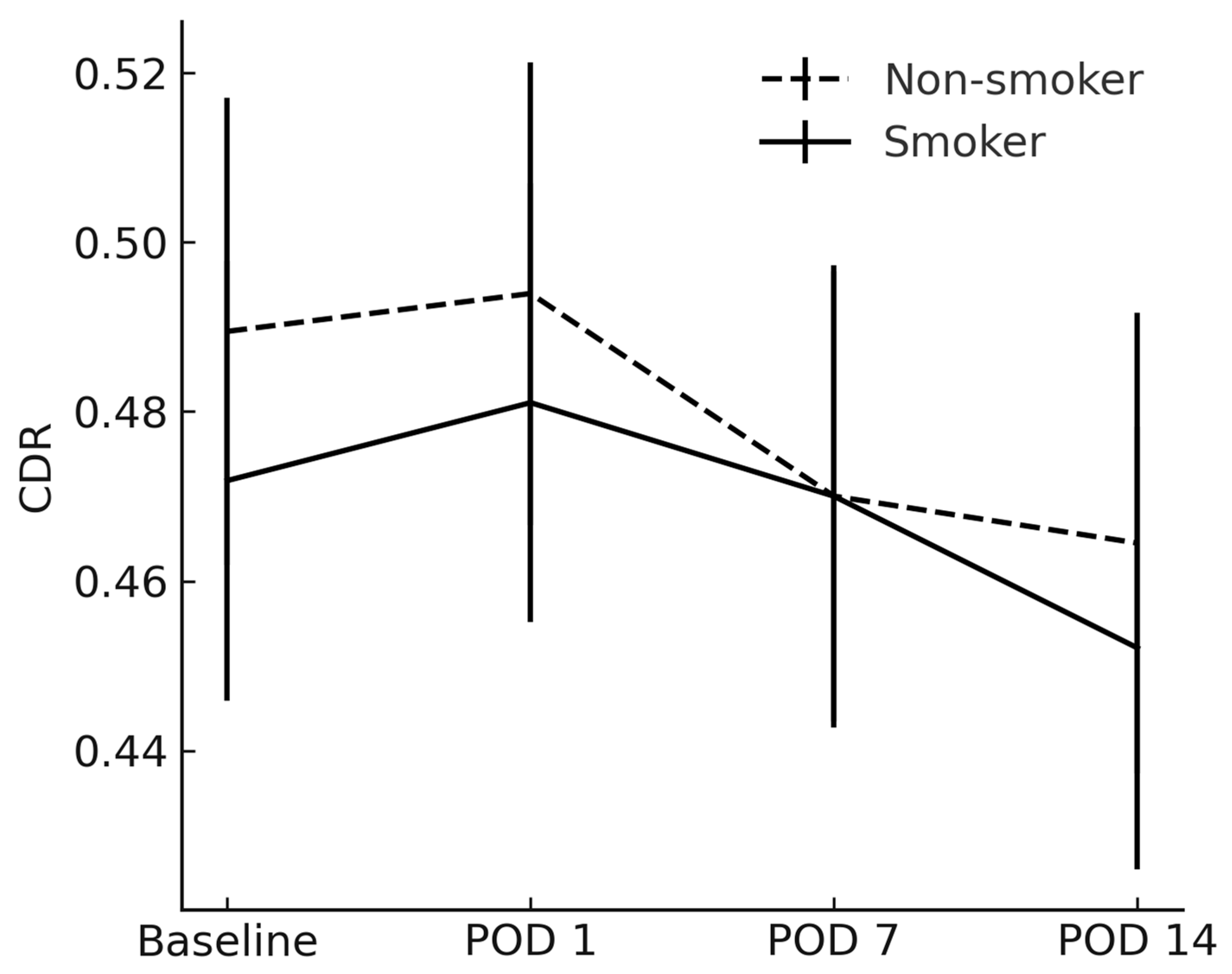
| Characteristics | Smokers (n = 40) | Non-Smokers (n = 40) | p-Value |
|---|---|---|---|
| Age (yrs) | 70.05 ± 5.54 | 73.84 ± 4.77 | 0.002 * |
| Male sex | 18 (47.4%) | 18 (47.4%) | 1.00 ‡ |
| Female sex | 20 (52.6%) | 20 (52.6%) | 1.00 ‡ |
| BMI (kg/m2) | 23.55 [22.12–24.85] | 24.65 [22.18–28.32] | 0.189 † |
| CDE | 9.05 [6.80–14.56] | 8.21 [6.32–11.13] | 0.170 † |
| CST 0 (µm) | 253.34 ± 15.10 | 262.24 ± 22.47 | 0.041 * |
| CV 0 (mm3) | 9.93 ± 0.59 | 10.02 ± 0.36 | 0.415 * |
| CAT 0 (µm) | 276.16 ± 15.37 | 277.71 ± 10.24 | 0.597 * |
| CST 1 (µm) | 249.50 [242–259] | 257.50 [245–273] | 0.044 † |
| CV 1 (mm3) | 9.73 ± 0.57 | 9.86 ± 0.36 | 0.262 * |
| CAT 1 (µm) | 269.71 ± 15.34 | 273.08 ± 10.17 | 0.251 * |
| CST 2 (µm) | 254.68 ± 15.31 | 262.34 ± 22.09 | 0.076 * |
| CV 2 (mm3) | 10.04 ± 0.58 | 10.00 ± 0.40 | 0.759 * |
| CAT 2 (µm) | 278.16 ± 15.45 | 278.47 ± 11.80 | 0.918 * |
| CST 3 (µm) | 258.32 ± 15.60 | 264.53 ± 22.75 | 0.159 * |
| CV 3 (mm3) | 10.30 ± 0.60 | 10.04 ± 0.38 | 0.026 * |
| CAT 3 (µm) | 285.11 ± 16.50 | 278.45 ± 10.87 | 0.037 * |
| RNFL 0 (µm) | 90.47 ± 7.60 | 90.92 ± 9.91 | 0.821 * |
| Avg. CDR 0 | 0.53 [0.46–0.58] | 0.52 [0.46–0.60] | 0.596 † |
| RNFL 1 (µm) | 89.76 ± 8.07 | 89.34 ± 10.51 | 0.841 * |
| Avg. CDR 1 | 0.54 [0.48–0.59] | 0.53 [0.45–0.61] | 0.840 † |
| RNFL 2 (µm) | 95.92 ± 7.59 | 93.76 ± 10.51 | 0.296 * |
| Avg. CDR 2 | 0.52 [0.45–0.59] | 0.52 [0.42–0.58] | 0.908 † |
| RNFL 3 (µm) | 97.84 ± 8.80 | 93.92 ± 10.06 | 0.067 * |
| Avg. CDR 3 | 0.49 [0.43–0.57] | 0.51 [0.42–0.57] | 0.795 † |
| Variable | LR χ2 (df = 3) | p (Group × Time) |
|---|---|---|
| CST (µm) | 1.8 | 0.618 |
| CV (mm3) | 13.0 | 0.0046 |
| CAT (µm) | 9.3 | 0.0100 |
| RNFL (µm) | 4.3 | 0.235 |
| Avg. CDR | 0.1 | 0.978 |
| Outcome (Δ) | β Phaco (95% CI) | p Phaco | β Smoker vs. NS | p Smoker | Adj. R2 |
| CST (µm) | +0.016 µm/min (−0.019 to +0.052) | 0.362 | +2.58 µm | 0.022 | 0.085 |
| CV (mm3) | +0.0004 mm3/min (−0.0016 to +0.0024) | 0.685 | +0.30 mm3 | <0.001 | 0.389 |
| CAT (µm) | +0.045 µm/min (−0.010 to +0.100) | 0.105 | +6.53 µm | <0.001 | 0.327 |
| RNFL (µm) | −0.005 µm/min (−0.048 to +0.038) | 0.812 | +4.22 µm | 0.001 | 0.175 |
| Avg. CDR | −0.0000/min (−0.0002 to +0.0002) | 0.901 | +0.005 | 0.274 | −0.020 |
| Outcome Δ | Interval | Phaco β NS | Phaco β S | p Phaco | CDE β NS | CDE β S | p CDE |
|---|---|---|---|---|---|---|---|
| CST (µm) | 0→1 d | +0.1036 µm/min | −0.0543 µm/min | 0.103 | +0.1227 µm/pc-s | +0.0921 µm/pc-s | 0.947 |
| CST (µm) | 1→7 d | −0.0506 | +0.1275 | 0.080 | −0.0730 | −0.1952 | 0.799 |
| CST (µm) | 7→14 d | −0.0292 | −0.0360 | 0.853 | +0.0304 | −0.0252 | 0.754 |
| CV (mm3) | 0→1 d | +0.0008 mm3/min | −0.0006 mm3/min | 0.469 | −0.0011 mm3/pc-s | +0.0056 mm3/pc-s | 0.460 |
| CV (mm3) | 1→7 d | −0.0004 | +0.0011 | 0.464 | +0.0002 | −0.0042 | 0.663 |
| CV (mm3) | 7→14 d | −0.0018 | +0.0009 | 0.127 | +0.0063 | −0.0009 | 0.385 |
| CAT (µm) | 0→1 d | +0.0282 µm/min | +0.0141 µm/min | 0.809 | −0.0603 µm/pc-s | −0.0777 µm/pc-s | 0.950 |
| CAT (µm) | 1→7 d | −0.0585 | +0.0738 | 0.022 | +0.5364 | −0.2277 | 0.006 |
| CAT (µm) | 7→14 d | −0.0170 | +0.0653 | 0.080 | −0.2785 | −0.1488 | 0.566 |
| RNFL (µm) | 0→1 d | +0.0057 µm/min | +0.0421 µm/min | 0.455 | +0.2889 µm/pc-s | −0.0245 µm/pc-s | 0.181 |
| RNFL (µm) | 1→7 d | −0.0079 | −0.0387 | 0.428 | +0.0172 | +0.1448 | 0.493 |
| RNFL (µm) | 7→14 d | −0.0014 | +0.0162 | 0.552 | −0.1373 | −0.0484 | 0.532 |
| Avg. CDR | 0→1 d | −0.0001 | +0.0001 | 0.163 | −0.0004 | −0.0002 | 0.781 |
| Avg. CDR | 1→7 d | +0.0001 | 0 | 0.584 | −0.0009 | +0.0002 | 0.322 |
| Avg. CDR | 7→14 d | −0.0001 | 0 | 0.872 | +0.0005 | −0.0006 | 0.239 |
Disclaimer/Publisher’s Note: The statements, opinions and data contained in all publications are solely those of the individual author(s) and contributor(s) and not of MDPI and/or the editor(s). MDPI and/or the editor(s) disclaim responsibility for any injury to people or property resulting from any ideas, methods, instructions or products referred to in the content. |
© 2025 by the authors. Licensee MDPI, Basel, Switzerland. This article is an open access article distributed under the terms and conditions of the Creative Commons Attribution (CC BY) license (https://creativecommons.org/licenses/by/4.0/).
Share and Cite
Batistic, D.; Glumac, S.; Dukic, J.J.; Rada, F.; Vrdoljak, J.; Batistic, J.; Boskovic, B.; Mizdrak, M.; Kreso, A. First Clinical Evidence Linking Smoking to Increased Postoperative Macular and Retinal Nerve Fiber Layer Thickness in Cataract Surgery Patients: A Prospective Cohort Study. J. Clin. Med. 2025, 14, 4131. https://doi.org/10.3390/jcm14124131
Batistic D, Glumac S, Dukic JJ, Rada F, Vrdoljak J, Batistic J, Boskovic B, Mizdrak M, Kreso A. First Clinical Evidence Linking Smoking to Increased Postoperative Macular and Retinal Nerve Fiber Layer Thickness in Cataract Surgery Patients: A Prospective Cohort Study. Journal of Clinical Medicine. 2025; 14(12):4131. https://doi.org/10.3390/jcm14124131
Chicago/Turabian StyleBatistic, Darko, Sandro Glumac, Jozefina Josipa Dukic, Filip Rada, Josip Vrdoljak, Jaksa Batistic, Braco Boskovic, Maja Mizdrak, and Ante Kreso. 2025. "First Clinical Evidence Linking Smoking to Increased Postoperative Macular and Retinal Nerve Fiber Layer Thickness in Cataract Surgery Patients: A Prospective Cohort Study" Journal of Clinical Medicine 14, no. 12: 4131. https://doi.org/10.3390/jcm14124131
APA StyleBatistic, D., Glumac, S., Dukic, J. J., Rada, F., Vrdoljak, J., Batistic, J., Boskovic, B., Mizdrak, M., & Kreso, A. (2025). First Clinical Evidence Linking Smoking to Increased Postoperative Macular and Retinal Nerve Fiber Layer Thickness in Cataract Surgery Patients: A Prospective Cohort Study. Journal of Clinical Medicine, 14(12), 4131. https://doi.org/10.3390/jcm14124131






